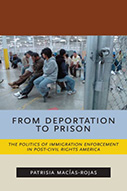FROM DEPORTATION TO PRISON: THE POLITICS OF IMMIGRATION ENFORCEMENT IN POST-CIVIL RIGHTS AMERICA

Author: Patrisia Macías-Rojas
Publisher: New York: New York University Press, 2016. 233p.
Reviewer: David Schultz | October 2017
The 2016 US presidential election thrust American immigration policy into the news headlines. Promising to build a wall along the Mexican border, Donald Trump labeled Mexican immigrants as rapists, criminals, and bad hombres, vowing to deport all the estimated 12 million undocumented individuals in the US. In his opening weeks as president, Trump issued a Muslim immigration ban from seven countries, only to see a federal court enjoin it, and he took other actions that portended an increase in deportation. This was especially the case considering a decision to reverse or modify an Obama policy that focused deportation upon those who had committed serious crimes, by expanding the list of offenses that could be considered grounds for removal. The Trump policies thus connect immigration, crime, and civil rights policy. But this intersection under Trump is not unique; it is a continuation of a 30-year set of policies in the US. At least according to Patrisia Macías-Rojas.
Macías-Rojas has produced a timely and powerful book that documents the criminalization of immigrants and immigration policy. Especially powerfully, she describes what she calls the “crimmigration” of immigration policy (23). It is a policy that is born out of a backlash against civil rights policy — seeing an increased punitive turn toward immigrants as a way to control and regulate them. There is, according to the author, not an antithetical but a complementary relationship between civil rights and criminalization; as oppressed groups press for their rights, often the response is to criminalize their behavior, to make their very status as individuals illegal. This is the case with undocumented aliens in the U.S.
The book begins with a story of the Arizona-Sonora desert border, the epicenter for immigration policy according to Macías-Rojas. The author draws upon the stories of immigrants–documented and not–who live along the border, and uses them to describe the evolution of US immigration policy. Beginning with the 1929 Immigration Act, unauthorized entry was treated as a civil and not a criminal issue. Macías-Rojas points to how, back even in the 1960s, immigration policy did not criminalize status. Individuals detained or found to be in the U.S. without proper documentation were told to leave or, if facing an immigration deportation hearing, were released on their own recognizance. This approach changed in the late 1960s when in partial response to the Civil Rights movements, the Nixon presidency launched a “get tough on crime” policing strategy. The latter was at least in part a reaction to the former. From Nixon to Reagan and the war on drugs, the focus was on increased criminalization for many acts that resulted in increased incarceration. This criminalization also produced the Criminal Alien Program, which in the 1980s led to the first wave of crimmigration. Individuals in the U.S. lacking proper documentation were treated as criminals and incarcerated prior to deportation or hearings.
The 1996 Illegal Immigration Reform and Immigrant Responsibility Act expanded criminal enforcement provisions and priorities, targeting those with criminal records. It also provided more funding for enforcement. Then came 9-11, merging even more so the issues of national security, law enforcement, and immigration. At that point, immigration became an even more salient issue, becoming part of a national presidential discourse in which the topic was an issue in the 2004 and subsequent campaigns.
While many might have expected President Bush to have been tough on immigration, Macías-Rojas points to how from Clinton through Bush and Obama, each president expanded aggressive enforcement and deportation of undocumented aliens, in part to relieve prison overcrowding. Contrary to what many may have thought, despite Obama’s rhetoric about immigration reform and trying to assist Dreamers (those unlawfully brought to the U.S. as children), his presidency was the most aggressive in history in terms of arrest and deportation.
Macías-Rojas’ book, written before Trump even became a candidate for president, describes a 30-year policy of increasing crimmigration. Trump’s rhetoric and enforcement actions thus represent a continuation, and not a break with a policy direction that was already well under way well before his election.
From Deportation to Prison is an excellent overview on the evolution of U.S. immigration policy. Its strength is the detailed discussion of the changing law enforcement policies along with the interviews of individuals affected by them. If there are any shortcomings in the book, they are that it does not go far enough in linking the crimmigration policies to political rhetoric and changes in the economy, given that it is the latter which helped fuel much of the anti-immigrant feeling in the last 40 years. But for those who want to understand the way politics and law now describe many individuals as criminals because of their status, this is a great book to read.
David Schultz, Professor, Department of Political Science, Hamline University, St. Paul, Minnesota.


